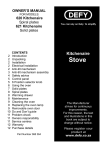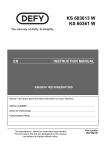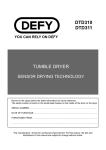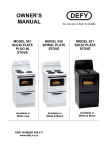Download Defy 570 Owner`s manual
Transcript
Owner's Manual You can rely on Defy INDEX 2 - Introduction 2 - Unpacking 2 - Before installation 2 - Removing the doors 3 - Replacing the doors 3 - Installation 3 - Electrical installation 4 - Levelling the refrigerator 4 - Caution notes 5 - Interior parts identification 6 - The control panel 6 - Setting the temperature 7 - Food storage tips 7 - Care and cleaning 8 - Replacing a faulty light bulb 8 - Owner’s responsibility 9 - Questions and answers 9 - Check 10 - Service centres 10 - Notes 11 - Notes 12 - Warranty 570 Side by Side Frost Free Refrigerator—Freezer The Manufacturer strives for continuous improvements. For this reason, the text and illustrations in this book are subject to change without notice www.defy.co.za Page 1 Introduction Congratulations on the purchase of this quality appliance. Please read these instructions carefully before using the product. This book will provide you with information on how to operate and care for your appliance in order that you gain the maximum benefit from it and enjoy many years of trouble free use. Unpacking • • • Please ensure that packaging material is disposed of in a responsible manner. Plastic bags should be cut up to prevent children playing with them and accidentally suffocating. If the appliance is damaged in any way, do not use it. Report the damage to your dealer, who will take the necessary corrective action. Before installation Measure the width of the kitchen entrance through which the unit must pass. The refrigerator measures 1790mm x 903mm x 735mm. (H x W x D incl. handles.) If the unit will not pass easily through the kitchen entrance, without risking damage, then either the kitchen door or those of the refrigerator or both should be removed to allow free passage. Once the unit is in position the doors can be re-fitted. Removing the freezer door 1. Remove the hinge cover screw. Insert a blade or small flat screw driver into the side groove of the hinge cover and pry it loose. Remove the hinge cover. 2. Turn the top hinge fastener 3 to 4 times in an anti-clockwise direction and disconnect the wiring harness 3. Remove the hinge by lifting the front and pulling it free. Be sure to hold the door securely as the top is now no longer secured. 4. Lift the door free of the bottom hinge pin. Removing the refrigerator door The refrigerator door has 1 earth wire to be unscrewed at the top hinge. Otherwise the procedure is the same as described above. Page 2 Replacing the freezer door 1 Lower the freezer door bottom hinge hole over the bottom hinge pin and close the door. 2 Slide the back of the top hinge into the slot and lower the hinge pin into the top hinge hole of the door. 3 Tighten the hinge fastener and re-connect the harness wiring. (earth wire for refrigerator door) 4 Snap the hinge cover in place and tighten the screw. Replacing the refrigerator door Repeat steps 1 to 4 as described above. Installation 1 The appliance should be positioned in a dry, well aired place away from heat sources such as stoves, geysers and direct sunlight. Allow an airspace at the rear of the refrigerator for ventilation purposes. 2 An electrical wall plug should be nearby and easily accessible. Electrical Installation 1 This appliance uses a 220-240V/50 Hz power supply. 2 The appliance should be plugged into a dedicated 15A earthed wall socket. Do not use an extension cord or multiple adaptor. 3 If the mains power cord is damaged, it must be replaced by a qualified electrician. 4 This appliance must be earthed and the manufacturer and the seller do not accept responsibility for any damage due to incorrect electrical connection. 5 This appliance may not be used with a battery inverter power supply. Page 3 Levelling the refrigerator It is advisable to adjust the cabinet so that it tilts slightly backwards. This will ensure that doors close properly. The doors must be aligned and the cabinet must stand level (left to right) To adjust levels proceed as follows: To adjust the freezer door: Insert a flat tip screw driver into the left front levelling foot and turn it. Clockwise will raise the unit and anti-clockwise will lower it. To adjust the refrigerator door: Repeat the procedure , turning the right hand levelling foot until the unit stands level and the doors are aligned. Caution notes • Never use flammable gas, benzene, thinners, petrol or other flammable liquids and sprays near the refrigerator. • Do not store flammable gas or liquids in the refrigerator or freezer. • Do not store medicine or academic research samples requiring strict temperature control in the refrigerator or freezer. • Always unplug the refrigerator when cleaning it. • Avoid touching metal freezer containers with bare hands as “cold burn” could result. • Do not store liquids, pot plants or open containers on top of the refrigerator as these might spill causing electrical shorting. • When discarding an old refrigerator please render the doors inoperative as children ,while playing, might get trapped inside and suffocate. • Do not place sealed liquid containers in the freezer. Liquids expand as they freeze and containers might rupture as a result. Page 4 Interior parts identification 1. Freezer door storage bins are used for storing items that need to be accessed readily. Do not store ice cream or foods requiring a long storage period in the topmost bin. 2. Freezer shelves are made of strong tempered glass and may be used for storing frozen foods such as meat, fish, and ice cream. 3. The top freezer drawer is ideal for storing dried foods like snoek and squid, for an extended period of time. 4. The bottom freezer drawer is for storing meat, poultry and fish for long periods of time. 5. Refrigerator shelves are made of strong tempered glass and may be used for storing everyday foods. 6. Movable storage bin. Do not use the bin for storing ice cubes nor place it in the freezer compartment. 7. The top crisper may be used to store vegetables. 8. The bottom crisper may be used to store fruit. 9. The dairy compartment is ideal for storing butter and cheese. 10. Refrigerator door storage bins offer convenient storage space for milk, bottles, jams and condiments. 11. Cold storage drawer for meats and fish which will be consumed shortly. Page 5 The control panel Insert the power cord plug into a wall socket and switch on. Four temperature sensors automatically regulate the temperatures in FUZZY both the freezer and refrigerator compartments The Fuzzy icon is always visible and indicates that the digital control system is operational. The antibiotic deodoriser mode works whenever the refrigerator is opDEODO erating and requires no maintenance. The deodoriser is located behind the vegetable crisper. Setting the freezer temperature • Press the FRZ SET button to select the desired freezer temperature. The temperatures are displayed sequentially as shown below. 19 • • 20 21 22 16 17 18 Press the SUPER FRZ button should you require faster freezing. The Super Freezer mode will end automatically after a period and the unit will re-set to the previously selected mode. The Super Freezer mode may be cancelled manually by pressing the button once more. Setting the refrigerator temperature • Press the RFR SET button to select the desired freezer temperature. The temperatures are displayed sequentially as shown below. 4 • • 3 2 8 7 6 5 Press the SUPER REF button should you require faster refrigeration. The Super Refrigeration mode will end automatically after a period and the unit will re-set to the previously selected mode. The Super Freezer mode may be cancelled manually by pressing the button once more. Note: The interior temperature can vary depending on the frequency of door openings and the ambient air temperature. Page 6 Food storage tips Freezer • Wash food before storing it. • Operate the freezer for 12 hours before loading it. • If you are loading bulk into the freezer, load one quarter at a time and allow to freeze before loading the next quarter. • Divide food into reasonable portions according to your requirements. • Allow hot food to cool before putting it in the freezer. • Seal all foods, or place in airtight containers to prevent dehydration. • Remember, liquids can increase in volume when frozen. Do not store sealed bottles, jars or cans in the freezer as the contents will freeze, expand and rupture the container. • Do not exceed the expiry date shown on food packs. Refrigerator • Be aware that tropical fruit like bananas can easily deteriorate if the storage temperature is too low. • Allow sufficient space between stored foods for the air to circulate. Care and cleaning • • • • • • • • • Always disconnect the plug from the mains socket before cleaning the appliance. Clean the inside of the appliance whenever necessary using a solution of warm water and Bicarbonate of Soda. ( 1 table spoon to every 2 litres of water ). Dry with a soft cloth. Do not use pot scourers or abrasive powders to clean the appliance. Do not use benzene, thinners or any volatile cleaners to clean any part of the refrigerator Spillages, especially citric and acidic juices, must be wiped up immediately as they could stain the product. The back of the unit may be vacuumed or dusted using a soft bristle brush. A mild furniture polish may be used on the exterior cabinet to add lustre and protect against finger marks. Shelves, freezer drawers, crispers and door bins may be removed for cleaning purposes. 1. To remove the dairy compartment flap, open it a little , hold with both hands and slide to the left To remove the dairy bin , hold both ends and lift upwards. 2. To remove a door bin, hold both ends of the bin and lift up. 3. To remove the shelves, open the doors fully and slide each shelf out. 4. To remove the crispers, lift slightly and pull free. Page 7 Replacing a faulty light bulb Refrigerator lamp 1. 2. 3. 4. Unscrew the screws securing the light cover. Hold the light cover and pull forward to remove it. Remove and replace the light bulb with one of similar specifications. Reassemble in reverse order. Freezer lamp 1. 2. 3. 4. Unscrew the screws securing the light cover. Hold the light cover and pull forward to remove it. Remove and replace the light bulb with one of similar specifications. Reassemble in reverse order. Owner’s responsibility Since the following are not factory faults they are the owners responsibility: • Damage to the exterior finish. • Damage caused by moving, installing or connecting the appliance incorrectly. • Breakage of glass, plastics and other components. • Replacement of light bulbs. • Damage caused through improper use of the appliance. Page 8 Questions and answers Why do the front and sides of the refrigera- Heating tubes are located beneath the surtor feel warm? face which are designed to prevent water vapour from condensing on a cold surface. Why are the doors sometimes difficult to open? When the door is closed and opened immediately thereafter, warm air which entered the refrigerator caused a pressure difference which tends to suck the door closed momentarily. Wait a little while and the door should open easily once more. Why does the refrigerator sometimes make These are normal and could be caused by a peculiar gurgling, buzzing or cracking the compressor, the defrost system, the fan, noise.? and material shrinkage / expansion Levelling the refrigerator can reduce these sounds. Why does moisture form on the interior walls and lamp housing? If the refrigerator or freezer is located in a hot and humid area, and the door is opened frequently, water droplets or dew may form on the interior walls of the appliance. This has no effect on the performance and the water may simply be wiped up using an absorbent cloth. Why is the refrigerator too warm or too cold? Set the freezer and refrigerator temperatures to a more suitable setting. Check: Before calling a service technician to assist with a problem, please check: • Are the temperatures set correctly? • Is the power switched OFF? The power should be ON. • Has a house fuse blown or a circuit tripped out? Repair or re-set as necessary. • Is the 15-amp plug pushed firmly into the wall socket? Check another appliance such as a toaster or kettle in the same socket. • Has the door been left open for a long time? Close the door and monitor performance. • Is there adequate provision for airflow at the rear of the unit.? • Are any of the shelves so tightly packed as to obstruct air flow between stored foods? Remember that you may be charged for a service call even during the warranty period if the fault is caused by any of the above. If you have followed the instructions and still have a problem, contact the nearest Defy Service Centre. They will be able to advise you on any aspect of the machine or send a qualified technician to repair it. Page 9 Service Centres If you have followed the instructions and still have a problem, consult your telephone directory for the nearest regional Defy Service Centre. They will advise on any aspect of the product, direct you to the nearest Service Agent or have it repaired by qualified technicians. Service Centres are located in Bloemfontein, Cape Town, Durban, East London, Johannesburg, Polokwane, Port Elizabeth and Pretoria. Other areas are serviced by over 200 authorised Service Agents. Further details may be obtained from our Web Site: www.defy.co.za Notes Page 10 Notes Page 11 Warranty This certificate is issued by DEFY APPLIANCES LIMITED manufacturers of Defy and Ocean products, hereinafter the Company, to the original purchaser only, of the appliance described on the certificate and shall constitute the only warranty given in respect of this appliance. The Company warrants to the original purchaser that for a period of TWO YEARS from date of purchase the appliance is free from defect under normal domestic use, both in workmanship and material, subject to the following conditions. 1. Repair or replacement of any part of this appliance, found by the Company to be defective, shall be at the election of the Company. The Company reserves the right to effect such service through any of its Service Divisions or Authorised Service Dealers. The cost of such service shall be borne by the Company in full, provided that the appliance is located no further than 50 km from a Company Service Centre or an Authorised Service Dealer. Where the appliance is located beyond the 50 km radius, the purchaser shall be liable for the standard travelling charges, as determined by the Company. CARRY IN SERVICE Microwave ovens, Compact cookers, Ice makers and small appliances are repaired in our service centres and are not collected from the customers home. Faulty units should be delivered to the purchasing dealer or to the nearest Company Service Centre for warranty repairs. 2. Vitreous enamelware, fuses and lamps are specifically excluded from these warranties. It is an express condition of these warranties that the purchaser takes due care and attention in the use and maintenance of the appliance. Abuse, misuse in conflict with operating instructions, connection to incorrect voltages and subjection to commercial use shall release the Company from its obligations. 3. This warranty shall become void and cease to operate if the appliance is dismantled by, or any repairs to the appliance are effected by any persons not duly authorised by the Company, or if substitute parts not approved by the Company are used in the appliance, or if the serial number of the appliance is removed. 4. The Company shall not be responsible for damages resulting from fire, flood, civil disturbances or any Act of God. The Company shall not, in terms of these warranties be responsible nor held liable for any consequential loss or damage of any kind caused by or due to the failure or malfunction of the appliance. 5. The Company shall not be responsible for transportation or other costs other than those incurred within the provisions of Point 1 of this Certificate. 6. These warranties shall not apply to the appliance if it is purchased or used beyond the borders of the Republic of South Africa, Namibia, Botswana, Swaziland and Lesotho. 7. Where service is requested under warranty and no fault or defect can be found by the Company, all costs incurred will be for the purchaser's account. 8. This Certificate as well as your invoice will serve as proof of purchase. For the purpose of warranty, it will be essential to produce this Certificate and invoice. Failure to do so, will render the purchaser liable for service costs. KEEP THIS CERTIFICATE AND SALES INVOICE AS PROOF OF PURCHASE FOR WARRANTY PURPOSES Page 12












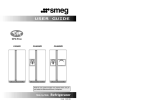
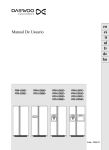
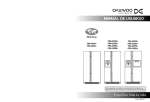
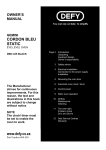
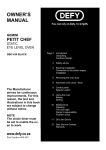
![8KG HEAT PUMP DRYER [Met DTD 315]](http://vs1.manualzilla.com/store/data/005851733_1-4b2b64d3b006b4e2563952fefa7cfd52-150x150.png)
